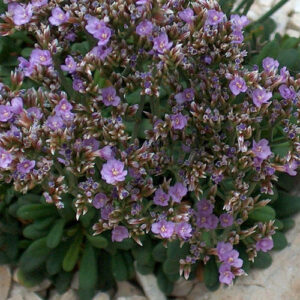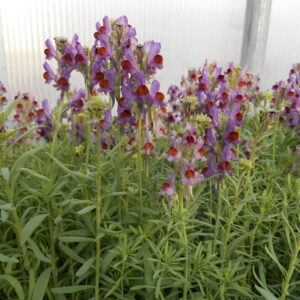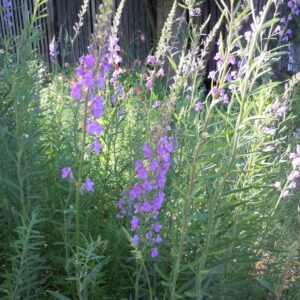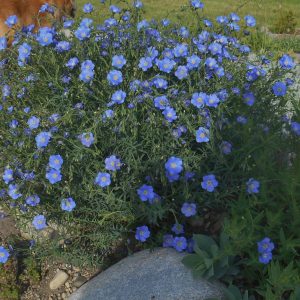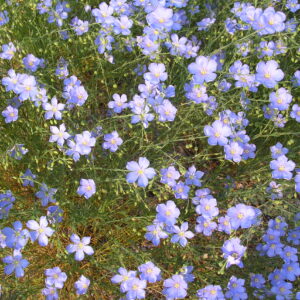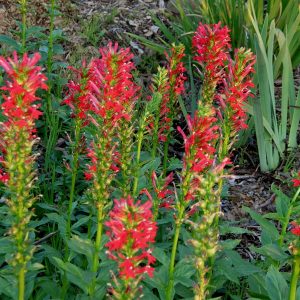Our Plants
Showing 361–368 of 584 results
-
Limonium minutum Dwarf statice Z 5-9
All summer long, droves of lavender blossoms above a mini pillow of spoon-shaped, glossy foliage.
OUT OF STOCK
All summer long, droves of lavender blossoms above a mini pillow of spoon-shaped, glossy foliage.
Size: 6-8” x 6-8”
Care: sun in well-drained soil
Native: southeast France on limestone seacliffs
Wildlife Value: deer resistant, salt tolerantDescribed by Linnaeus, 1753. The name Limoniuim comes from the Greek word for meadow.
-
Linaria alpina Alpine toadflax Z 5-8
Purple snapdragon-like petals bloom all summer and show off golden-orange lips
OUT OF STOCK
Purple snapdragon-like petals bloom all summer and show off golden-orange lips
Size: 4-6” x 6-12”
Care: sun in well-drained soil
Native: Mountains of central and southern EuropeListed in Gardeners Dictionary, 1768. Wm Robinson in July 1872 issue of The Garden: “The alpine Linaria is never more beautiful than when self-sown in a gravel walk.” January 1876 bloomed for 4+ months in the rock garden at Edinburgh Botanic Garden.
-
Linaria purpurea Purple toadflax Z 5-9
Violet racemes all summer July to September
Violet racemes all summer through fall
Size: 36” x 12”
Care: Sun, well-drained soil
Native: Southern EuropeBoth the Latin and common names are related to flax. Linaria comes from “linum” which is Greek for “flax” and toadflax includes the word “flax.” The leaves of Linaria purpurea resemble flax leaves. According to 17th century English herbalist, John Parkinson, the plant “causes one to make water.” Grown by English plantsman and explorer, Tradescant the Elder, 1634.
-
Linum alpinum Alpine flax, Mountain flax Z 4-9
Compact blue flax, perfect for the rock garden or in a sunny border. Bushy mound of small soft-blue saucers for weeks in late spring & early summer. Reblooms if you cut it half way back in late June
Compact blue flax, perfect for the rock garden or in a sunny border. Bushy mound of small soft-blue saucers for weeks in late spring & early summer. Reblooms if you cut it half way back in late June
Size: 8-12” x 10-12”
Care: sun in well-drained soil
Native: mountains of EuropePublished as a separate species in 1925.
-
Linum perenne ‘Lewisii’ Perennial flax, Prairie flax Z 4-8
Sky blue flowers closing by afternoon all summer
Sky blue flowers closing by afternoon all summer
Size: 18" x 12"
Care: Full sun in well-drained soil.
Native: Wisconsin west and southLimonium is Greek meaning “meadow” and latifolium means “wide leaf”. This was identified by Dioscorides in De Materica Medica for medicinal use around 70 A.D. Cultivated in gardens since 1700’s. Formerly used to repel moths and cure canker sores.
-
Liriodendron tulipfera Tulip tree Z 4-9
Large tulip-shaped yellow-green petals surround orange corolla, Ornamental leaves turn yellow in fall
Large tulip-shaped yellow-green petals surround orange corolla, Ornamental leaves turn yellow in fall
Size: 80-100’ x 30’
Care: sun in well drained to moist well drained soil. Fast growing and strong wood.
Native: New England to FL, Ontario to IL, south to Louisiana and all states in between.
Wildlife Value: attracts Tiger swallowtail butterfly.
Awards: Recipient Great Plant Pick Award from Elizabeth Carey Miller Botanical Garden & England’s Royal Horticultural Society Award of Merit & Great Plants for Great PlainsOne of the oldest flowering trees – about 95 million years old. Cherokee cured pinworms, cholera, dysentery, coughs, wounds, boils, fever, bone fractures, indigestion, snakebites, and “women with hysterics” with Tulip tree. Because it is light weight but strong they made canoes for up to 20 people with Tulip tree wood. The Rappahannock chewed the bark as a stimulant for sex. Sent to Europe by Tradescant before 1640. Grown by Jefferson. Washington planted them as an allée around the serpentine bowling green.
State tree of Indiana, Kentucky, North Carolina and Tennessee.
**LISTED AS OUT OF STOCK BECAUSE WE DO NOT SHIP THIS ITEM. IT IS AVAILABLE FOR PURCHASE AT OUR RETAIL LOCATION.
-
Lobelia cardinalis Cardinal flower Z 3-9
Ruby, cardinal red tubes with an upper lip split in half and a lower lip like a pixie’s apron encircle the spike from August to October beckon hummingbirds to feed.
Ruby, cardinal red tubes with an upper lip split in half and a lower lip like a pixie’s apron encircle the spike from August to October beckon hummingbirds to feed.
Size: 3’ x 12”
Care: sun to part shade in fertile, moist soil. Moist soil important
Native: Canada to Texas, Wisconsin native.
Wildlife Value: attracts hummingbirds
Awards: Received England’s Royal Horticultural Society Award of Merit & Missouri Botanic Garden Plant of Merit.Cherokee cured stomach aches, worms, pain, fever, nose bleeds, rheumatism, headaches, colds, and croup with Lobelia. They used the root to treat syphilis. Other Natives and colonists used the plant to induce vomiting. At the end of a funeral, Meskwaki Indians threw the dried and pulverized plant into the grave. Meskwaki also chopped the roots and secretly put it in the food of “a quarrelsome pair.” Allegedly “this makes the pair love each other again.” Lobelia is named for Matthias L’Obel (1538-1616) French expatriate who immigrated to England and became physician to English King James I. Tradescant the Younger introduced this to European gardens when he sent it to England in 1637. Offered for sale in Bartram Garden’s 1783 Broadside. In 1749 Swedish botanist Peter Kalm wrote that Indians used five species of Lobelia to cure venereal disease, “an infallible art of curing it.” Grown by Washington at Mount Vernon and Thomas Jefferson at Monticello. Pressed specimen in Emily Dickinson’s herbarium.
-
Lobelia siphilitica ‘Alba’ z 4-8
A striking, erect spike of pure white blossoms opening from bottom up. On top club-shaped buds, below trumpet-shapes made of a tube flaring open at the ends with the top of the flare looking like a quarter moon with the circle at the bottom and the lower divided into three, each segment pointed at the ends. Its fresh white blooms stand out in late summer to early fall.
A striking, erect spike of pure white blossoms opening from bottom up. On top club-shaped buds, below trumpet-shapes made of a tube flaring open at the ends with the top of the flare looking like a quarter moon with the circle at the bottom and the lower divided into three, each segment pointed at the ends. Its fresh white blooms stand out in late summer to early fall.
Size: 2-3’ x 1-2’
Care: sun to part shade in moist or moist well-drained soil
Native: The blue form, the species Lobelia siphilitica is native from Connecticut to Wyoming, south to Texas then east to Georgia and all states in between, Wisconsin native.
Wildlife Value: Deer resistant, attracts bees, hummingbirds and some butterflies.This white one is “An albino of occasional occurrence.” Britton, Nathaniel Lord “On the Naming of ‘Forms,’ in the New Jersey Catalogue” Bulletin of the Torrey Botanical Club 17: 121,125. 1890. This may, therefore, be native in the same locations as the blue species or it may not.

